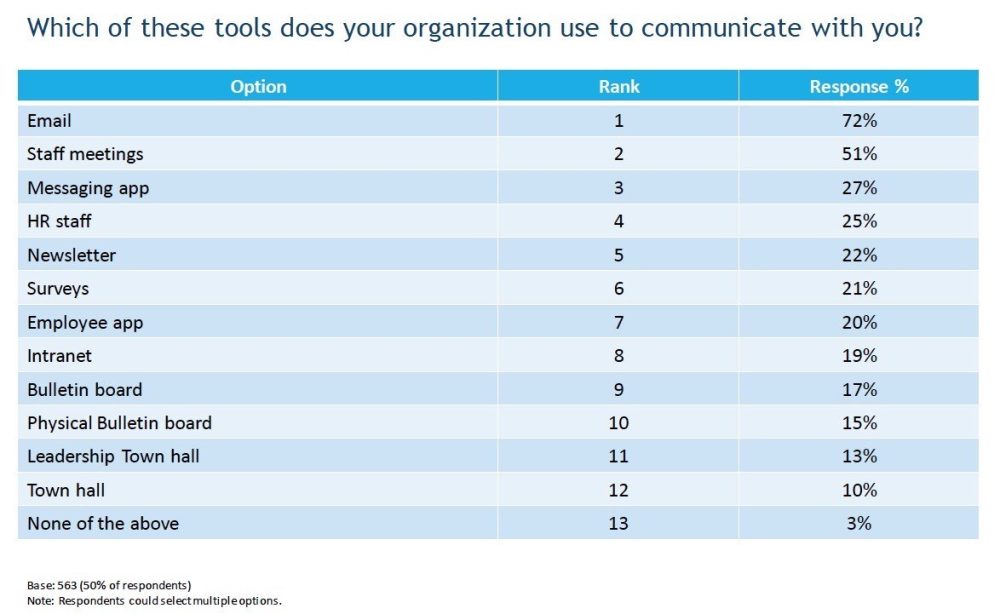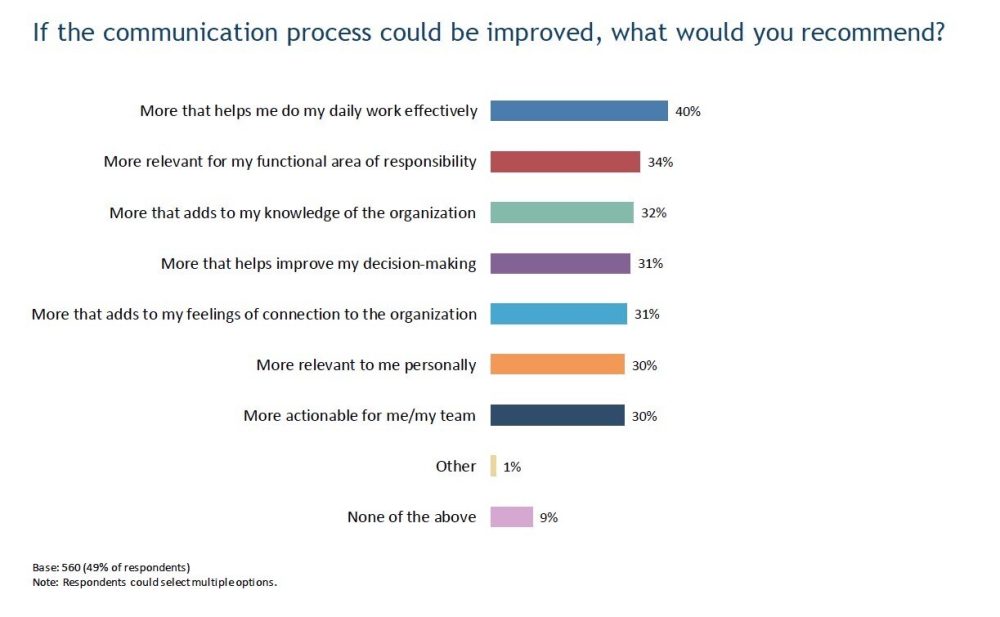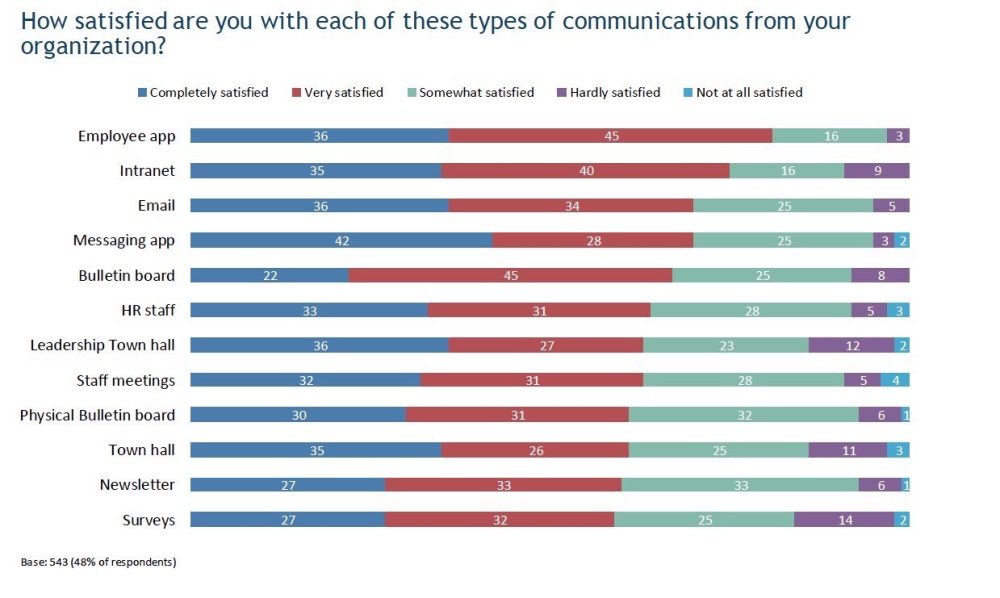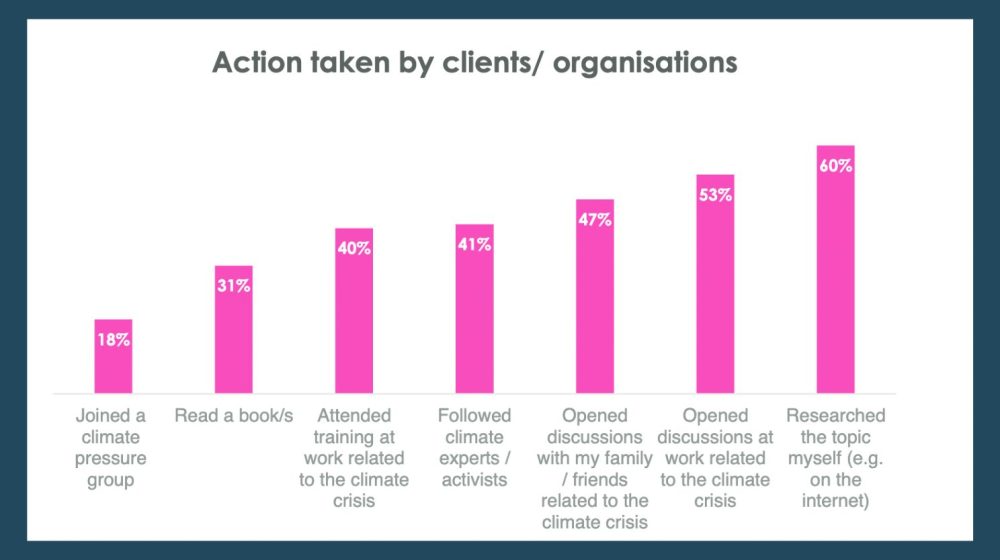 This research is provided by the IPR Measurement CommissionThe COVID-19 pandemic spurred a resurgence in employee communication. As previously in-office workers began logging on from coffee shops, vacation homes, and residences, communication leaders worried about company culture even as overall productivity exceeded expectations. A pertinent question, however, was tactical rather than strategic in nature:What means of communication were most effective not only for operational matters, but for strategic and cultural priorities?There are many examples of research seeking to determine the “right” way to communicate with employees to assure operational and strategic performance, and to support communication channels that enable strategic impact.O’Neil, Ewing, Smith, and Williams (2018) sought the opinion of senior internal communication professionals and scholars to determine standards for employee communication measurement. These scholars articulated a four-step process for measurement and evaluation in 2021. These steps are: Aligning communication and organizational objectives, identifying stakeholders and the strategy to engage them, measuring outputs, outtakes, outcomes and/or impacts as per the AMEC 2020 methodology, and finally evaluating and improving those measured results. They also examined relevant innovations in technology and digital channel measurement, encouraging professionals to push beyond surface-level metrics to measure behavior. Artificial Intelligence will no doubt present challenges, they note, particularly as regards chatbots and gaming where it already has a toehold.Ruck and Welch (2012) recount the long history of various means of measuring internal communication, most notably connecting communication tactics with employee preferences by topic, and the need of fostering identification with the organization to enhance employee engagement. They further expanded this research with Menara (2017) into the role of employee voice in business impact, with strong implications for selecting communication methods that support and promote that employee voice. With much research covering employee engagement, Ruck, et. al., narrow their focus to whether employees feel like they contribute to organizational performance. Regarding measurement, Ruck has a simple tip: “Avoid focusing on outputs such as page visits and look at the outcomes such as understanding and behavior change.” (Ruck 2015, para. 12). Dortok (2006) examined internal communication generally and its impact on corporate reputation, finding that effective internal communication plans that include frequent measurement and focus on sharing business objectives result in a contribution to positive reputation. Instead of seeing IC and reputation as separate, they have a symbiotic relationship, Dortok observes, with positive reputation driving more effective communication, which then enhances reputation further. What sort of content encourages that reputational impact? Dortok recommends a blend of financial and nonfinancial business results as ideal, with an eye to tactics that allow for personal interaction. A word of caution: This research should be repeated as it is now about 20 years old!Internal social media, or enterprise social media (ESM), has been the focus of the work of several scholars. ESM includes tools such as Microsoft’s Teams and Yammer, Jive, Slack, and others. This category also includes employee apps like Firstup, TheEmployeeApp, and Staffbase. Current research does not closely differentiate among these products; some focus on the instant messaging realm and others on a more robust mobile first platform.The central idea is that tools that people use outside the enterprise could be employed as employee communication tools. Uptake of these resources, however, is very uneven, and there are pitfalls. Labban and Bizzi (2023) found a paradox where employees will enthusiastically use the social tools, but expend less effort on their work duties! Wu, Pitafi, A. H., Pitafi, S., & Ren (2021) saw a relationship between use of internal social (of which employee apps are a big part) and information overload. They suggested that organizations may need to train their employees to use such tools effectively.This researchWhat appears to be missing from the literature is a more general evaluation of employee perspectives on internal communication tools. To explore this, we added several questions to an omnibus survey by Researchscape International of 1,134 U.S. adults fielded from May 12-14, 2023. Our sub-sample of 563 full-time or part-time employees were asked questions about internal communication. Each employee worked at an organization with more than a single worker.The key findings were enlightening both for professionals and scholars: 1.) The overall perception of employee communication was moderately positive.2.) The most commonly used tool for employee communication was email (72%), followed by staff meetings (51%) and then, a distant third, messaging apps (27%).3.) In terms of overall satisfaction, fewer than two-thirds were satisfied with employee communication, and 4 out of 10 said the most prominent area of improvement was “content that helps me do my daily work more effectively.”4.) Broader, more strategic material, however, is far from irrelevant; about one-third said adding to their knowledge of the organization would also be impactful.
This research is provided by the IPR Measurement CommissionThe COVID-19 pandemic spurred a resurgence in employee communication. As previously in-office workers began logging on from coffee shops, vacation homes, and residences, communication leaders worried about company culture even as overall productivity exceeded expectations. A pertinent question, however, was tactical rather than strategic in nature:What means of communication were most effective not only for operational matters, but for strategic and cultural priorities?There are many examples of research seeking to determine the “right” way to communicate with employees to assure operational and strategic performance, and to support communication channels that enable strategic impact.O’Neil, Ewing, Smith, and Williams (2018) sought the opinion of senior internal communication professionals and scholars to determine standards for employee communication measurement. These scholars articulated a four-step process for measurement and evaluation in 2021. These steps are: Aligning communication and organizational objectives, identifying stakeholders and the strategy to engage them, measuring outputs, outtakes, outcomes and/or impacts as per the AMEC 2020 methodology, and finally evaluating and improving those measured results. They also examined relevant innovations in technology and digital channel measurement, encouraging professionals to push beyond surface-level metrics to measure behavior. Artificial Intelligence will no doubt present challenges, they note, particularly as regards chatbots and gaming where it already has a toehold.Ruck and Welch (2012) recount the long history of various means of measuring internal communication, most notably connecting communication tactics with employee preferences by topic, and the need of fostering identification with the organization to enhance employee engagement. They further expanded this research with Menara (2017) into the role of employee voice in business impact, with strong implications for selecting communication methods that support and promote that employee voice. With much research covering employee engagement, Ruck, et. al., narrow their focus to whether employees feel like they contribute to organizational performance. Regarding measurement, Ruck has a simple tip: “Avoid focusing on outputs such as page visits and look at the outcomes such as understanding and behavior change.” (Ruck 2015, para. 12). Dortok (2006) examined internal communication generally and its impact on corporate reputation, finding that effective internal communication plans that include frequent measurement and focus on sharing business objectives result in a contribution to positive reputation. Instead of seeing IC and reputation as separate, they have a symbiotic relationship, Dortok observes, with positive reputation driving more effective communication, which then enhances reputation further. What sort of content encourages that reputational impact? Dortok recommends a blend of financial and nonfinancial business results as ideal, with an eye to tactics that allow for personal interaction. A word of caution: This research should be repeated as it is now about 20 years old!Internal social media, or enterprise social media (ESM), has been the focus of the work of several scholars. ESM includes tools such as Microsoft’s Teams and Yammer, Jive, Slack, and others. This category also includes employee apps like Firstup, TheEmployeeApp, and Staffbase. Current research does not closely differentiate among these products; some focus on the instant messaging realm and others on a more robust mobile first platform.The central idea is that tools that people use outside the enterprise could be employed as employee communication tools. Uptake of these resources, however, is very uneven, and there are pitfalls. Labban and Bizzi (2023) found a paradox where employees will enthusiastically use the social tools, but expend less effort on their work duties! Wu, Pitafi, A. H., Pitafi, S., & Ren (2021) saw a relationship between use of internal social (of which employee apps are a big part) and information overload. They suggested that organizations may need to train their employees to use such tools effectively.This researchWhat appears to be missing from the literature is a more general evaluation of employee perspectives on internal communication tools. To explore this, we added several questions to an omnibus survey by Researchscape International of 1,134 U.S. adults fielded from May 12-14, 2023. Our sub-sample of 563 full-time or part-time employees were asked questions about internal communication. Each employee worked at an organization with more than a single worker.The key findings were enlightening both for professionals and scholars: 1.) The overall perception of employee communication was moderately positive.2.) The most commonly used tool for employee communication was email (72%), followed by staff meetings (51%) and then, a distant third, messaging apps (27%).3.) In terms of overall satisfaction, fewer than two-thirds were satisfied with employee communication, and 4 out of 10 said the most prominent area of improvement was “content that helps me do my daily work more effectively.”4.) Broader, more strategic material, however, is far from irrelevant; about one-third said adding to their knowledge of the organization would also be impactful.
 SO WHAT?1.) Ensure that email and staff meetings are properly supported and encouraged. They remain ubiquitous, though the level of satisfaction is higher for employee apps and intranet than for email and staff meetings. Improving the satisfaction level for such common tools should yield enhanced results.2.) Know your employees, organizations, and operations. Add and improve content regarding work performance to your mix. Help employees know the organization better and make content as relevant as possible to their areas of responsibility.3.) Measurement should reach across several data points, starting with usage of communication tools and satisfaction of employee communication, but not stopping there. Employees’ perception of usefulness and relevancy can be compared to performance factors to determine what influences are best at enhancing employee performance.
SO WHAT?1.) Ensure that email and staff meetings are properly supported and encouraged. They remain ubiquitous, though the level of satisfaction is higher for employee apps and intranet than for email and staff meetings. Improving the satisfaction level for such common tools should yield enhanced results.2.) Know your employees, organizations, and operations. Add and improve content regarding work performance to your mix. Help employees know the organization better and make content as relevant as possible to their areas of responsibility.3.) Measurement should reach across several data points, starting with usage of communication tools and satisfaction of employee communication, but not stopping there. Employees’ perception of usefulness and relevancy can be compared to performance factors to determine what influences are best at enhancing employee performance.
 TELL ME MORE!HOW CAN WE MAKE EMAIL MORE EFFECTIVE?It’s a hard balance between issuing enough reminders for action-oriented email and spamming your recipients. Our research suggests that employees may need three or even four reminders if they are expected to respond to an email. For informational emails that don’t require action, that would probably be way too many reminders.HOW CAN WE MAXIMIZE EMPLOYEE ENGAGEMENT?The question is, rather, what do we want employees to DO when they are engaged? How about looking at advocacy instead? Our data show that the more satisfied employees are with internal communication, the more they advocate for their organization. Even people in the middle of the satisfaction scale are fairly likely to advocate publicly at a moderate rate. Try focusing on improving the perception of value of your communications, with an eye toward having employees become true brand ambassadors.IF EMPLOYEES ARE ONLY MODERATELY SATISFIED WITH CERTAIN CHANNELS, SHOULD WE STOP USING THEM?Our data shows that the types of communication that have moderate satisfaction rates are still valuable. For example, a physical bulletin board is rated highly by 61% of our respondents. Staff meetings are rated at 63%. That’s a tight gap! Plus, perhaps the physical bulletin board is more popular among employees who don’t sit at desks, or who work more independently. What is your strategy and how do these tools fit?INTERNAL SOCIAL: FAD, FOLLY OR FAB?Employee apps are one of the most popular tools among organizations that use them, but only about 20% of respondents said their organization uses them. It’s tempting to look at the 81% satisfaction rate among employees who use apps and immediately decide to run with them. There is indeed a strong relationship between use of the apps and overall satisfaction, but the relatively small number of users compels us to highlight the need for more evidence before our unqualified endorsement.CONCLUSIONAt this time, with this dataset, email is seen as the best tool for internal communicators, and the relatively easy means of measuring not only outputs like open rates and clicks-through, but downstream behavioral action makes it an easy choice. Determining the lag between distribution of information and intended action is an urgent need, as is measurement of the clarity of strategy, and its alignment with organizational objectives. Given the level of variability in industries, size of organization strategy and purpose of communication action, we need more research, especially within the enterprise.As much as all of us would like to have a singular, generalizable “truth” for strategy, tactics and measurement for internal communication – it probably doesn’t exist. Keep striving!
TELL ME MORE!HOW CAN WE MAKE EMAIL MORE EFFECTIVE?It’s a hard balance between issuing enough reminders for action-oriented email and spamming your recipients. Our research suggests that employees may need three or even four reminders if they are expected to respond to an email. For informational emails that don’t require action, that would probably be way too many reminders.HOW CAN WE MAXIMIZE EMPLOYEE ENGAGEMENT?The question is, rather, what do we want employees to DO when they are engaged? How about looking at advocacy instead? Our data show that the more satisfied employees are with internal communication, the more they advocate for their organization. Even people in the middle of the satisfaction scale are fairly likely to advocate publicly at a moderate rate. Try focusing on improving the perception of value of your communications, with an eye toward having employees become true brand ambassadors.IF EMPLOYEES ARE ONLY MODERATELY SATISFIED WITH CERTAIN CHANNELS, SHOULD WE STOP USING THEM?Our data shows that the types of communication that have moderate satisfaction rates are still valuable. For example, a physical bulletin board is rated highly by 61% of our respondents. Staff meetings are rated at 63%. That’s a tight gap! Plus, perhaps the physical bulletin board is more popular among employees who don’t sit at desks, or who work more independently. What is your strategy and how do these tools fit?INTERNAL SOCIAL: FAD, FOLLY OR FAB?Employee apps are one of the most popular tools among organizations that use them, but only about 20% of respondents said their organization uses them. It’s tempting to look at the 81% satisfaction rate among employees who use apps and immediately decide to run with them. There is indeed a strong relationship between use of the apps and overall satisfaction, but the relatively small number of users compels us to highlight the need for more evidence before our unqualified endorsement.CONCLUSIONAt this time, with this dataset, email is seen as the best tool for internal communicators, and the relatively easy means of measuring not only outputs like open rates and clicks-through, but downstream behavioral action makes it an easy choice. Determining the lag between distribution of information and intended action is an urgent need, as is measurement of the clarity of strategy, and its alignment with organizational objectives. Given the level of variability in industries, size of organization strategy and purpose of communication action, we need more research, especially within the enterprise.As much as all of us would like to have a singular, generalizable “truth” for strategy, tactics and measurement for internal communication – it probably doesn’t exist. Keep striving!
 REFERENCESDortok, A. (2006). A managerial look at the interaction between internal communication and corporate reputation. Corporate Reputation Review, 8(4), 322-338. https://doi.org/10.1057/palgrave.crr.1540258.Labban, A., and Bizzi, L. (2023). Communication via social media: How employees will paradoxically support the organization while putting less effort at work. International Journal of Business Communication. 60. (2). Pp. 487-511. Retrieved May 9, 2023, from https://doi-org.ezproxy.bgsu.edu/10.1177/23294884211005526Li Y, Pitafi AH, Li H. Investigating the factors of enterprise social media strain: The role of enterprise social media’s visibility as a moderator. PLoS One. 2022 Mar 8;17(3):e0264726. Doi: 10.1371/journal.pone.0264726. PMID: 35259183; PMCID: PMC8903258.Men, L. R., O’Neil, J., & Ewing, M. (2020). Examining the effects of internal social media usage on employee engagement. Public Relations Review, 46(2), 101880. https://doi.org/10.1016/j.pubrev.2020.101880
...
REFERENCESDortok, A. (2006). A managerial look at the interaction between internal communication and corporate reputation. Corporate Reputation Review, 8(4), 322-338. https://doi.org/10.1057/palgrave.crr.1540258.Labban, A., and Bizzi, L. (2023). Communication via social media: How employees will paradoxically support the organization while putting less effort at work. International Journal of Business Communication. 60. (2). Pp. 487-511. Retrieved May 9, 2023, from https://doi-org.ezproxy.bgsu.edu/10.1177/23294884211005526Li Y, Pitafi AH, Li H. Investigating the factors of enterprise social media strain: The role of enterprise social media’s visibility as a moderator. PLoS One. 2022 Mar 8;17(3):e0264726. Doi: 10.1371/journal.pone.0264726. PMID: 35259183; PMCID: PMC8903258.Men, L. R., O’Neil, J., & Ewing, M. (2020). Examining the effects of internal social media usage on employee engagement. Public Relations Review, 46(2), 101880. https://doi.org/10.1016/j.pubrev.2020.101880
...
Read More...

 Axios HQ examined the best time to send an internal email in order to boost employee engagement.
The company analyzed the average open rates of 8.7 million email deliveries over 215 different organizations between January 2022 – March 2023.
Key findings include:
70% of employees preferred their employer send vital internal updates by email.
The best days to send an email were Sunday (54% open rate) and Monday (54% open rate).
Tuesday (52%) and Wednesday (52%) had the next highest open rates.
Saturday (31%) had the lowest open rate.
Internal emails that were sent from 3 a.m. – 6 a.m. had the highest open rate (70%) likely due to the fact that they are at the top of an employee’s inbox at the start of the workday.
12 a.m – 3 a.m. was the next best time, with a 65% open rate.
Read the full report here
...
Axios HQ examined the best time to send an internal email in order to boost employee engagement.
The company analyzed the average open rates of 8.7 million email deliveries over 215 different organizations between January 2022 – March 2023.
Key findings include:
70% of employees preferred their employer send vital internal updates by email.
The best days to send an email were Sunday (54% open rate) and Monday (54% open rate).
Tuesday (52%) and Wednesday (52%) had the next highest open rates.
Saturday (31%) had the lowest open rate.
Internal emails that were sent from 3 a.m. – 6 a.m. had the highest open rate (70%) likely due to the fact that they are at the top of an employee’s inbox at the start of the workday.
12 a.m – 3 a.m. was the next best time, with a 65% open rate.
Read the full report here
... 
 This research is provided by the IPR Measurement CommissionThe COVID-19 pandemic spurred a resurgence in employee communication. As previously in-office workers began logging on from coffee shops, vacation homes, and residences, communication leaders worried about company culture even as overall productivity exceeded expectations. A pertinent question, however, was tactical rather than strategic in nature:What means of communication were most effective not only for operational matters, but for strategic and cultural priorities?There are many examples of research seeking to determine the “right” way to communicate with employees to assure operational and strategic performance, and to support communication channels that enable strategic impact.O’Neil, Ewing, Smith, and Williams (2018) sought the opinion of senior internal communication professionals and scholars to determine standards for employee communication measurement. These scholars articulated a four-step process for measurement and evaluation in 2021. These steps are: Aligning communication and organizational objectives, identifying stakeholders and the strategy to engage them, measuring outputs, outtakes, outcomes and/or impacts as per the AMEC 2020 methodology, and finally evaluating and improving those measured results. They also examined relevant innovations in technology and digital channel measurement, encouraging professionals to push beyond surface-level metrics to measure behavior. Artificial Intelligence will no doubt present challenges, they note, particularly as regards chatbots and gaming where it already has a toehold.Ruck and Welch (2012) recount the long history of various means of measuring internal communication, most notably connecting communication tactics with employee preferences by topic, and the need of fostering identification with the organization to enhance employee engagement. They further expanded this research with Menara (2017) into the role of employee voice in business impact, with strong implications for selecting communication methods that support and promote that employee voice. With much research covering employee engagement, Ruck, et. al., narrow their focus to whether employees feel like they contribute to organizational performance. Regarding measurement, Ruck has a simple tip: “Avoid focusing on outputs such as page visits and look at the outcomes such as understanding and behavior change.” (Ruck 2015, para. 12). Dortok (2006) examined internal communication generally and its impact on corporate reputation, finding that effective internal communication plans that include frequent measurement and focus on sharing business objectives result in a contribution to positive reputation. Instead of seeing IC and reputation as separate, they have a symbiotic relationship, Dortok observes, with positive reputation driving more effective communication, which then enhances reputation further. What sort of content encourages that reputational impact? Dortok recommends a blend of financial and nonfinancial business results as ideal, with an eye to tactics that allow for personal interaction. A word of caution: This research should be repeated as it is now about 20 years old!Internal social media, or enterprise social media (ESM), has been the focus of the work of several scholars. ESM includes tools such as Microsoft’s Teams and Yammer, Jive, Slack, and others. This category also includes employee apps like Firstup, TheEmployeeApp, and Staffbase. Current research does not closely differentiate among these products; some focus on the instant messaging realm and others on a more robust mobile first platform.The central idea is that tools that people use outside the enterprise could be employed as employee communication tools. Uptake of these resources, however, is very uneven, and there are pitfalls. Labban and Bizzi (2023) found a paradox where employees will enthusiastically use the social tools, but expend less effort on their work duties! Wu, Pitafi, A. H., Pitafi, S., & Ren (2021) saw a relationship between use of internal social (of which employee apps are a big part) and information overload. They suggested that organizations may need to train their employees to use such tools effectively.This researchWhat appears to be missing from the literature is a more general evaluation of employee perspectives on internal communication tools. To explore this, we added several questions to an omnibus survey by Researchscape International of 1,134 U.S. adults fielded from May 12-14, 2023. Our sub-sample of 563 full-time or part-time employees were asked questions about internal communication. Each employee worked at an organization with more than a single worker.The key findings were enlightening both for professionals and scholars: 1.) The overall perception of employee communication was moderately positive.2.) The most commonly used tool for employee communication was email (72%), followed by staff meetings (51%) and then, a distant third, messaging apps (27%).3.) In terms of overall satisfaction, fewer than two-thirds were satisfied with employee communication, and 4 out of 10 said the most prominent area of improvement was “content that helps me do my daily work more effectively.”4.) Broader, more strategic material, however, is far from irrelevant; about one-third said adding to their knowledge of the organization would also be impactful.
This research is provided by the IPR Measurement CommissionThe COVID-19 pandemic spurred a resurgence in employee communication. As previously in-office workers began logging on from coffee shops, vacation homes, and residences, communication leaders worried about company culture even as overall productivity exceeded expectations. A pertinent question, however, was tactical rather than strategic in nature:What means of communication were most effective not only for operational matters, but for strategic and cultural priorities?There are many examples of research seeking to determine the “right” way to communicate with employees to assure operational and strategic performance, and to support communication channels that enable strategic impact.O’Neil, Ewing, Smith, and Williams (2018) sought the opinion of senior internal communication professionals and scholars to determine standards for employee communication measurement. These scholars articulated a four-step process for measurement and evaluation in 2021. These steps are: Aligning communication and organizational objectives, identifying stakeholders and the strategy to engage them, measuring outputs, outtakes, outcomes and/or impacts as per the AMEC 2020 methodology, and finally evaluating and improving those measured results. They also examined relevant innovations in technology and digital channel measurement, encouraging professionals to push beyond surface-level metrics to measure behavior. Artificial Intelligence will no doubt present challenges, they note, particularly as regards chatbots and gaming where it already has a toehold.Ruck and Welch (2012) recount the long history of various means of measuring internal communication, most notably connecting communication tactics with employee preferences by topic, and the need of fostering identification with the organization to enhance employee engagement. They further expanded this research with Menara (2017) into the role of employee voice in business impact, with strong implications for selecting communication methods that support and promote that employee voice. With much research covering employee engagement, Ruck, et. al., narrow their focus to whether employees feel like they contribute to organizational performance. Regarding measurement, Ruck has a simple tip: “Avoid focusing on outputs such as page visits and look at the outcomes such as understanding and behavior change.” (Ruck 2015, para. 12). Dortok (2006) examined internal communication generally and its impact on corporate reputation, finding that effective internal communication plans that include frequent measurement and focus on sharing business objectives result in a contribution to positive reputation. Instead of seeing IC and reputation as separate, they have a symbiotic relationship, Dortok observes, with positive reputation driving more effective communication, which then enhances reputation further. What sort of content encourages that reputational impact? Dortok recommends a blend of financial and nonfinancial business results as ideal, with an eye to tactics that allow for personal interaction. A word of caution: This research should be repeated as it is now about 20 years old!Internal social media, or enterprise social media (ESM), has been the focus of the work of several scholars. ESM includes tools such as Microsoft’s Teams and Yammer, Jive, Slack, and others. This category also includes employee apps like Firstup, TheEmployeeApp, and Staffbase. Current research does not closely differentiate among these products; some focus on the instant messaging realm and others on a more robust mobile first platform.The central idea is that tools that people use outside the enterprise could be employed as employee communication tools. Uptake of these resources, however, is very uneven, and there are pitfalls. Labban and Bizzi (2023) found a paradox where employees will enthusiastically use the social tools, but expend less effort on their work duties! Wu, Pitafi, A. H., Pitafi, S., & Ren (2021) saw a relationship between use of internal social (of which employee apps are a big part) and information overload. They suggested that organizations may need to train their employees to use such tools effectively.This researchWhat appears to be missing from the literature is a more general evaluation of employee perspectives on internal communication tools. To explore this, we added several questions to an omnibus survey by Researchscape International of 1,134 U.S. adults fielded from May 12-14, 2023. Our sub-sample of 563 full-time or part-time employees were asked questions about internal communication. Each employee worked at an organization with more than a single worker.The key findings were enlightening both for professionals and scholars: 1.) The overall perception of employee communication was moderately positive.2.) The most commonly used tool for employee communication was email (72%), followed by staff meetings (51%) and then, a distant third, messaging apps (27%).3.) In terms of overall satisfaction, fewer than two-thirds were satisfied with employee communication, and 4 out of 10 said the most prominent area of improvement was “content that helps me do my daily work more effectively.”4.) Broader, more strategic material, however, is far from irrelevant; about one-third said adding to their knowledge of the organization would also be impactful.
 SO WHAT?1.) Ensure that email and staff meetings are properly supported and encouraged. They remain ubiquitous, though the level of satisfaction is higher for employee apps and intranet than for email and staff meetings. Improving the satisfaction level for such common tools should yield enhanced results.2.) Know your employees, organizations, and operations. Add and improve content regarding work performance to your mix. Help employees know the organization better and make content as relevant as possible to their areas of responsibility.3.) Measurement should reach across several data points, starting with usage of communication tools and satisfaction of employee communication, but not stopping there. Employees’ perception of usefulness and relevancy can be compared to performance factors to determine what influences are best at enhancing employee performance.
SO WHAT?1.) Ensure that email and staff meetings are properly supported and encouraged. They remain ubiquitous, though the level of satisfaction is higher for employee apps and intranet than for email and staff meetings. Improving the satisfaction level for such common tools should yield enhanced results.2.) Know your employees, organizations, and operations. Add and improve content regarding work performance to your mix. Help employees know the organization better and make content as relevant as possible to their areas of responsibility.3.) Measurement should reach across several data points, starting with usage of communication tools and satisfaction of employee communication, but not stopping there. Employees’ perception of usefulness and relevancy can be compared to performance factors to determine what influences are best at enhancing employee performance.
 TELL ME MORE!HOW CAN WE MAKE EMAIL MORE EFFECTIVE?It’s a hard balance between issuing enough reminders for action-oriented email and spamming your recipients. Our research suggests that employees may need three or even four reminders if they are expected to respond to an email. For informational emails that don’t require action, that would probably be way too many reminders.HOW CAN WE MAXIMIZE EMPLOYEE ENGAGEMENT?The question is, rather, what do we want employees to DO when they are engaged? How about looking at advocacy instead? Our data show that the more satisfied employees are with internal communication, the more they advocate for their organization. Even people in the middle of the satisfaction scale are fairly likely to advocate publicly at a moderate rate. Try focusing on improving the perception of value of your communications, with an eye toward having employees become true brand ambassadors.IF EMPLOYEES ARE ONLY MODERATELY SATISFIED WITH CERTAIN CHANNELS, SHOULD WE STOP USING THEM?Our data shows that the types of communication that have moderate satisfaction rates are still valuable. For example, a physical bulletin board is rated highly by 61% of our respondents. Staff meetings are rated at 63%. That’s a tight gap! Plus, perhaps the physical bulletin board is more popular among employees who don’t sit at desks, or who work more independently. What is your strategy and how do these tools fit?INTERNAL SOCIAL: FAD, FOLLY OR FAB?Employee apps are one of the most popular tools among organizations that use them, but only about 20% of respondents said their organization uses them. It’s tempting to look at the 81% satisfaction rate among employees who use apps and immediately decide to run with them. There is indeed a strong relationship between use of the apps and overall satisfaction, but the relatively small number of users compels us to highlight the need for more evidence before our unqualified endorsement.CONCLUSIONAt this time, with this dataset, email is seen as the best tool for internal communicators, and the relatively easy means of measuring not only outputs like open rates and clicks-through, but downstream behavioral action makes it an easy choice. Determining the lag between distribution of information and intended action is an urgent need, as is measurement of the clarity of strategy, and its alignment with organizational objectives. Given the level of variability in industries, size of organization strategy and purpose of communication action, we need more research, especially within the enterprise.As much as all of us would like to have a singular, generalizable “truth” for strategy, tactics and measurement for internal communication – it probably doesn’t exist. Keep striving!
TELL ME MORE!HOW CAN WE MAKE EMAIL MORE EFFECTIVE?It’s a hard balance between issuing enough reminders for action-oriented email and spamming your recipients. Our research suggests that employees may need three or even four reminders if they are expected to respond to an email. For informational emails that don’t require action, that would probably be way too many reminders.HOW CAN WE MAXIMIZE EMPLOYEE ENGAGEMENT?The question is, rather, what do we want employees to DO when they are engaged? How about looking at advocacy instead? Our data show that the more satisfied employees are with internal communication, the more they advocate for their organization. Even people in the middle of the satisfaction scale are fairly likely to advocate publicly at a moderate rate. Try focusing on improving the perception of value of your communications, with an eye toward having employees become true brand ambassadors.IF EMPLOYEES ARE ONLY MODERATELY SATISFIED WITH CERTAIN CHANNELS, SHOULD WE STOP USING THEM?Our data shows that the types of communication that have moderate satisfaction rates are still valuable. For example, a physical bulletin board is rated highly by 61% of our respondents. Staff meetings are rated at 63%. That’s a tight gap! Plus, perhaps the physical bulletin board is more popular among employees who don’t sit at desks, or who work more independently. What is your strategy and how do these tools fit?INTERNAL SOCIAL: FAD, FOLLY OR FAB?Employee apps are one of the most popular tools among organizations that use them, but only about 20% of respondents said their organization uses them. It’s tempting to look at the 81% satisfaction rate among employees who use apps and immediately decide to run with them. There is indeed a strong relationship between use of the apps and overall satisfaction, but the relatively small number of users compels us to highlight the need for more evidence before our unqualified endorsement.CONCLUSIONAt this time, with this dataset, email is seen as the best tool for internal communicators, and the relatively easy means of measuring not only outputs like open rates and clicks-through, but downstream behavioral action makes it an easy choice. Determining the lag between distribution of information and intended action is an urgent need, as is measurement of the clarity of strategy, and its alignment with organizational objectives. Given the level of variability in industries, size of organization strategy and purpose of communication action, we need more research, especially within the enterprise.As much as all of us would like to have a singular, generalizable “truth” for strategy, tactics and measurement for internal communication – it probably doesn’t exist. Keep striving!
 REFERENCESDortok, A. (2006). A managerial look at the interaction between internal communication and corporate reputation. Corporate Reputation Review, 8(4), 322-338. https://doi.org/10.1057/palgrave.crr.1540258.Labban, A., and Bizzi, L. (2023). Communication via social media: How employees will paradoxically support the organization while putting less effort at work. International Journal of Business Communication. 60. (2). Pp. 487-511. Retrieved May 9, 2023, from https://doi-org.ezproxy.bgsu.edu/10.1177/23294884211005526Li Y, Pitafi AH, Li H. Investigating the factors of enterprise social media strain: The role of enterprise social media’s visibility as a moderator. PLoS One. 2022 Mar 8;17(3):e0264726. Doi: 10.1371/journal.pone.0264726. PMID: 35259183; PMCID: PMC8903258.Men, L. R., O’Neil, J., & Ewing, M. (2020). Examining the effects of internal social media usage on employee engagement. Public Relations Review, 46(2), 101880. https://doi.org/10.1016/j.pubrev.2020.101880
...
REFERENCESDortok, A. (2006). A managerial look at the interaction between internal communication and corporate reputation. Corporate Reputation Review, 8(4), 322-338. https://doi.org/10.1057/palgrave.crr.1540258.Labban, A., and Bizzi, L. (2023). Communication via social media: How employees will paradoxically support the organization while putting less effort at work. International Journal of Business Communication. 60. (2). Pp. 487-511. Retrieved May 9, 2023, from https://doi-org.ezproxy.bgsu.edu/10.1177/23294884211005526Li Y, Pitafi AH, Li H. Investigating the factors of enterprise social media strain: The role of enterprise social media’s visibility as a moderator. PLoS One. 2022 Mar 8;17(3):e0264726. Doi: 10.1371/journal.pone.0264726. PMID: 35259183; PMCID: PMC8903258.Men, L. R., O’Neil, J., & Ewing, M. (2020). Examining the effects of internal social media usage on employee engagement. Public Relations Review, 46(2), 101880. https://doi.org/10.1016/j.pubrev.2020.101880
... 
 This summary is provided by the IPR ESG and Purpose Research LibraryDr. CB Bhattacharya and Rob Jekielek analyzed whether employers were prompting employees to conduct business with sustainability in mind.Surveys of 1,056 managers were conducted in fall 2022 by The Harris Poll and the University of Pittsburgh’s Center for Sustainable Business.Key findings include:1.) 36% of the respondents strongly agreed with the statement “My company wants to make a difference in people’s lives, not just make profits.”2.) 29% of respondents strongly agreed that their company has a clear business case for improving sustainability performance.— Top challenges for improving sustainability performance included short-term focus (43%), a lack of investor interest (43%), and leadership not believing in sustainability (43%).3.) 45% of employees indicated that they don’t know what actions to take to improve sustainability performance.— 45% identified a belief among employees that sustainability is someone else’s responsibility.4.) 24% of respondents strongly agreed that every business decision they make is viewed through the lens of sustainability.Read the full report here
...
This summary is provided by the IPR ESG and Purpose Research LibraryDr. CB Bhattacharya and Rob Jekielek analyzed whether employers were prompting employees to conduct business with sustainability in mind.Surveys of 1,056 managers were conducted in fall 2022 by The Harris Poll and the University of Pittsburgh’s Center for Sustainable Business.Key findings include:1.) 36% of the respondents strongly agreed with the statement “My company wants to make a difference in people’s lives, not just make profits.”2.) 29% of respondents strongly agreed that their company has a clear business case for improving sustainability performance.— Top challenges for improving sustainability performance included short-term focus (43%), a lack of investor interest (43%), and leadership not believing in sustainability (43%).3.) 45% of employees indicated that they don’t know what actions to take to improve sustainability performance.— 45% identified a belief among employees that sustainability is someone else’s responsibility.4.) 24% of respondents strongly agreed that every business decision they make is viewed through the lens of sustainability.Read the full report here
... 



 Jackie Kolek is Executive Vice President and Chief Innovation Officer at Peppercomm. She is also a new member of IPR ELEVATE. She currently leads Peppercomm’s financial and professional services sector, developing and executing fully-integrated campaigns. Over her nearly 30-year career, she has worked at some of the industry’s leading firms and is member of Page Up and the Wiseman.
...
Jackie Kolek is Executive Vice President and Chief Innovation Officer at Peppercomm. She is also a new member of IPR ELEVATE. She currently leads Peppercomm’s financial and professional services sector, developing and executing fully-integrated campaigns. Over her nearly 30-year career, she has worked at some of the industry’s leading firms and is member of Page Up and the Wiseman.
... 
 PRCA examined the perceptions of public relations practitioners toward their role in communicating the climate crisis.A survey of 230 communications practitioners was conducted from June 1-27, 2023.Key findings include:1.) 95% of practitioners are advising clients/colleagues on how they can communicate the part they play in the climate crisis.2.) 47% of clients/organizations are implementing sustainability policies and practices.— 44% are taking measures to reduce their carbon footprint— 38% are contributing to debates on the subject— 34% are educating their consumers in their communication and carbon footprint measures.3.) 44% said the knowledge their clients/organizations have of climate change is often “incorrect” or “misinformed.”— 58% feel like their client/organization needs to be an expert in order to contribute to the debate.4.) 57% feel like the organization they work for is not doing enough to tackle the climate crisis.— 33% have experienced requirements for team members to travel for meetings that could have been online.— 20% have had clients/bosses not believing in the climate crisis in general.Read the full report here
PRCA examined the perceptions of public relations practitioners toward their role in communicating the climate crisis.A survey of 230 communications practitioners was conducted from June 1-27, 2023.Key findings include:1.) 95% of practitioners are advising clients/colleagues on how they can communicate the part they play in the climate crisis.2.) 47% of clients/organizations are implementing sustainability policies and practices.— 44% are taking measures to reduce their carbon footprint— 38% are contributing to debates on the subject— 34% are educating their consumers in their communication and carbon footprint measures.3.) 44% said the knowledge their clients/organizations have of climate change is often “incorrect” or “misinformed.”— 58% feel like their client/organization needs to be an expert in order to contribute to the debate.4.) 57% feel like the organization they work for is not doing enough to tackle the climate crisis.— 33% have experienced requirements for team members to travel for meetings that could have been online.— 20% have had clients/bosses not believing in the climate crisis in general.Read the full report here
 ...
... 
 Pew Research Center analyzed the evolution of the #BlackLivesMatter hashtag on Twitter and examined how individuals engage with social issues on social media.An analysis of 44 million public tweets over the last 10 years was conducted along with a survey of 5,000 U.S. adults from May 15-21, 2023.Key findings include:1.) 77% of social media users have come across content related to the Black Lives Matter Movement.— 24% of users have posted or shared content in support of the movement, and 10% have posted or shared content in opposition of the movement.2.) 81% of U.S. adults believe police violence against black people is a problem.3.) 43% say social media is “extremely effective” or “very effective” way to bring attention to this issue compared to only 32% who say news organizations are “extremely effective” or “very effective.”— However, 76% of U.S. adults said “social media makes people think they’re making a difference when they really aren’t.”4.) 30% of social media users said these sites were “very important” or “somewhat important” to them for getting involved with issues they care about, a decrease from 44% in 2020.Read the full report here
...
Pew Research Center analyzed the evolution of the #BlackLivesMatter hashtag on Twitter and examined how individuals engage with social issues on social media.An analysis of 44 million public tweets over the last 10 years was conducted along with a survey of 5,000 U.S. adults from May 15-21, 2023.Key findings include:1.) 77% of social media users have come across content related to the Black Lives Matter Movement.— 24% of users have posted or shared content in support of the movement, and 10% have posted or shared content in opposition of the movement.2.) 81% of U.S. adults believe police violence against black people is a problem.3.) 43% say social media is “extremely effective” or “very effective” way to bring attention to this issue compared to only 32% who say news organizations are “extremely effective” or “very effective.”— However, 76% of U.S. adults said “social media makes people think they’re making a difference when they really aren’t.”4.) 30% of social media users said these sites were “very important” or “somewhat important” to them for getting involved with issues they care about, a decrease from 44% in 2020.Read the full report here
... 
 This summary is provided by the IPR ESG & Purpose Research LibraryThe Yale Program on Climate Change Communication researched American voters’ opinions on domestic climate and energy policies.A national survey of 861 registered U.S. voters was conducted April 18 – May 1, 2023.Key findings include:1.) 54% of registered voters thought global warming should be a “high” or “very high” priority for President Joe Biden and Congress.— 88% of liberal Democrats thought global warming was a “high” or “very high” priority, followed by 41% of liberal/moderate Republicans, and 9% of conservative Republicans.2.) 79% of registered voters said they support additional funding for renewable energy research.— 98% of liberal Democrats supported funding for renewable energy research, followed by 70% of liberal/moderate Republicans, and 50% of conservative Republicans.3.) 70% of registered voters said corporations and industries should do “more” or “much more” to address global warming.— 63% of registered voters said U.S. Congress should do more to address global warming.— 54% said President Joe Biden should do more.Read the full report here
...
This summary is provided by the IPR ESG & Purpose Research LibraryThe Yale Program on Climate Change Communication researched American voters’ opinions on domestic climate and energy policies.A national survey of 861 registered U.S. voters was conducted April 18 – May 1, 2023.Key findings include:1.) 54% of registered voters thought global warming should be a “high” or “very high” priority for President Joe Biden and Congress.— 88% of liberal Democrats thought global warming was a “high” or “very high” priority, followed by 41% of liberal/moderate Republicans, and 9% of conservative Republicans.2.) 79% of registered voters said they support additional funding for renewable energy research.— 98% of liberal Democrats supported funding for renewable energy research, followed by 70% of liberal/moderate Republicans, and 50% of conservative Republicans.3.) 70% of registered voters said corporations and industries should do “more” or “much more” to address global warming.— 63% of registered voters said U.S. Congress should do more to address global warming.— 54% said President Joe Biden should do more.Read the full report here
... 
 Dr. Grant Packard and Dr. Jonah Berger analyzed how the use of concrete language shaped consumer behavior and satisfaction. Concrete language was defined as the use of “specific, tangible, and real” words.An analysis of 200 customer service calls from a large American apparel retailer and 941 customer service interactions from a Canadian multi-channel retailer were conducted. In addition, three surveys of 1,102 crowdsourced employees were conducted.Key findings include:— Consumers were more satisfied with employees that used concrete language and thought they were more helpful.—- Concrete language was defined as language that made people feel heard, made things more “memorable,” and made the “abstract” more “concrete.”—- Abstract language was defined as language that referred to the “bigger picture.”—- Concrete language focused on the “how” and abstract language focused on the “why.”— Consumers that interacted with concrete language spent 30% more time with the retailer in the following weeks.— Respondents perceived employees who spoke concretely as “more attentive to” and “understanding of” their needs.Discover why concrete language impacts consumers the mostRead the original study here.
...
Dr. Grant Packard and Dr. Jonah Berger analyzed how the use of concrete language shaped consumer behavior and satisfaction. Concrete language was defined as the use of “specific, tangible, and real” words.An analysis of 200 customer service calls from a large American apparel retailer and 941 customer service interactions from a Canadian multi-channel retailer were conducted. In addition, three surveys of 1,102 crowdsourced employees were conducted.Key findings include:— Consumers were more satisfied with employees that used concrete language and thought they were more helpful.—- Concrete language was defined as language that made people feel heard, made things more “memorable,” and made the “abstract” more “concrete.”—- Abstract language was defined as language that referred to the “bigger picture.”—- Concrete language focused on the “how” and abstract language focused on the “why.”— Consumers that interacted with concrete language spent 30% more time with the retailer in the following weeks.— Respondents perceived employees who spoke concretely as “more attentive to” and “understanding of” their needs.Discover why concrete language impacts consumers the mostRead the original study here.
...